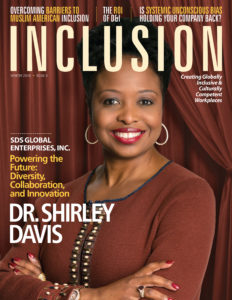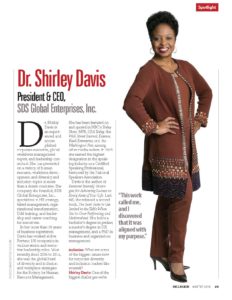Read the Interview Below…


Dr. Shirley Davis is an experienced and accomplished corporate executive, global workforce management expert, and leadership consultant. She has presented on a variety of human resource, workforce development, and diversity and inclusion topics in more than a dozen countries. The company she founded, SDS Global Enterprises, Inc., specializes in HR strategy, talent management, organizational transformation, D&I training, and leadership and career coaching for executives.
In her more than 30 years of business experience, Davis has worked at five Fortune 100 companies in various senior and executive leadership roles. Most recently, from 2006 to 2014, she was the global head of diversity and inclusion and workplace strategies for the Society for Human Resource Management.
She has been featured on and quoted in NBC’s Today Show, NPR, USA Today, the Wall Street Journal, Essence, Black Enterprise, and the Washington Post, among other media outlets. In 2015 she earned the highest designation in the speaking industry as a Certified Speaking Professional, bestowed by the National Speakers Association.
Davis is the author of Reinvent Yourself: Strategies for Achieving Success in Every Area of Your Life. Last fall, she released a second book, The Seat: How to Get Invited to the Table When You’re Over-Performing and Undervalued. She holds a bachelor’s degree in pre-law, a master’s degree in HR management, and a Ph.D. in business and organization management.
Inclusion: What are some of the biggest issues now for corporate diversity and inclusion leaders like yourself?
Shirley Davis: One of the biggest challenges we’re facing right now that impacts our field is the political climate. It has put diversity and inclusion front and center and not in a good way. Americans and even the global community are recovering from what was deemed as one of the most disruptive, divisive, and emotionally charged elections in modern history. It elevated some very sensitive and unhealed wounds in our history. It also uncovered some really nasty and unhealthy biases that are still pervasive and prevalent in our society. And it revealed just how much further we have to go in order to achieve parity, equity, dignity, respect, and inclusion.
Another big challenge we face is the need to reinvent and transform corporate culture. Corporate cultures have not kept pace as this era of disruption has redefined the way that we think, work, and communicate, and the way that we embrace difference. Many corporations are responding and reacting instead of leading, and therefore they are being disrupted instead of anticipating the shifts and being the disruptors and change leaders.
IN: There is much greater emphasis in recent years on inclusion. Has that superseded diversity as the focus and, if so, why?
SD: We’re seeing more companies recognizing that you can have diversity and not have inclusion. Diversity is the mix of cultural and ethnic backgrounds, experiences, preferences, physical characteristics, thinking styles, gender and identity, and other personal attributes. But inclusion is all about the workplace culture and how it enables these differences to work well together. In previous years, companies were more focused on diversity as an act of representation—compliance, “checking the box,” and raising awareness through training. But today those same companies are also recognizing that that alone is not sufficient. They are recognizing that inclusion drives everything from innovation to talent acquisition, employee engagement to greater problem solving, better customer service to retention, and, as a result, greater performance overall.
IN: What brought you to do this work? Is there a personal motivation or story from your childhood or past that inspired you in this direction?
SD: I didn’t grow up aspiring to be a global HR or diversity and inclusion workforce thought leader. This work called me, and I discovered that it was aligned with my purpose, interests, strengths, and mission in life. What motivated me to do this work was that it afforded me the opportunity to help organizations and leaders better understand that talent comes in all shapes, sizes, colors, backgrounds, beliefs, experiences, family structures, ethnicities, and genders.
This work is also personal for me. In The Seat: How to Get Invited to the Table When You’re Over-Performing and Undervalued, I share in detail my feelings of being “the only one” in so many instances, and my personal experiences of being marginalized, insulted, and discriminated against simply because I was a woman, a single mom, and a person of color.
Too many of my colleagues are still experiencing the same thing, so in my book I outline several strategies for what I had to do to take back my personal power and to overcome the effects of these biases to earn a seat at the table. In this work, I also have the opportunity to influence behavior and mindsets, and to assist in the development of new policies, strategies, and outcomes to ensure that people like me have a level playing field.
IN: Tell us about your greatest success story.
SD: I have a number of successes and achievement that I’m very proud of. One would be going back to school to get my master’s and Ph.D. My initial intent and motive in getting those advanced degrees came more from being marginalized and overlooked [in the workplace] and being told that if you just do this and if you just get that or go through this class or take this certification, then we’ll give you the promotion or job. I was already doing the work anyway, getting great results, and I was training others who didn’t look like me, either my male counterparts or white female counterparts, but they were getting the promotions and I was not. So I got my Ph.D. and multiple certifications. And while I still experienced biases and minimization, I took pride in the fact that I accomplished it while I was still working full-time, being a single mom, and traveling quite a bit in a demanding job.
The other thing I’m really proud of is that I made the decision a few years ago to build my exit strategy and to look at how I could take control of my own destiny. So I made a decision that it was time for me take a risk, take a leap of faith, and create my own global consulting, speaking, and training enterprise to leverage all of the wisdom, education, experiences, and successes that I had accumulated. I am thrilled to report that the business is doing extremely well.
IN: What are some of the recent thought-leader topics in the world of inclusion that organizations are learning about and implementing?
SD: There are at least 10 that I am currently working with organizations to address. I’ll touch on a few. First, companies are realizing that they have to provide more career mobility and flexibility for their workers. It means a shift in their strategies, policies, systems, attitudes, and behaviors. Because we now live in a digital world and are hyperconnected, work gets done in very different ways, in different places and spaces, on various schedules, and in different time zones. Second, inclusion drives innovation and, when properly implemented, can impact a company’s ROI, ROE [return on equity], ROS [return on sales], and even ROL [return on leaders]. Lastly, unconscious bias, inclusive leadership, and courageous conversations have become even more significant, particularly given our political environment.
IN: As more and more millennials join the job force and baby boomers are slowly aging, has this phenomenon provided challenges for your clients? What are some suggestions for addressing these challenges?
SD: Many companies are not ready for the generational shift, and it is causing missed opportunities in talent acquisition, retention, productivity, and innovation. I help companies find ways to bridge communication gaps and maximize each generation’s strengths and contributions versus dwelling on stereotypes and biases. I also assist them in creating cultures that all talent can thrive in.
IN: How will the CDO role change in the next five years? Will more be expected of CDOs?
SD: What I’m seeing more and more is that chief diversity officers are having to be more globally focused—meaning they need to consider the global workforce and marketplace, as well as cultural contexts. I’ve also seen the role of CDO move into different roles and reporting relationships. There was a time when many of my colleagues were reporting directly to the CEOs. Now I’ve seen a shift as diversity and inclusion is coming under HR. One reason for this is that, in general, chief diversity officers have not always done a good job of talking about the numbers, the analytics, the impact, the longer-term importance of D&I as a sustainable business strategy. That has hurt the role of CDO in a lot of ways because it has not been seen as a strategic business, global, innovative business leader. Instead it has been seen as a glorified part of HR.
As CDOs, we must have the boldness, courage, and skill set necessary to have crucial conversations and use them as opportunities to build bridges, create understanding, and allow for collaboration.
IN: How does a company best cultivate a diverse talent pipeline?
SD: As I have headed up recruiting for a number of years in previous companies, one of the things I’ve found that’s been a best practice in cultivating talent pipelines is developing relationships, [promoting] community building, and creating a great culture for employees that keeps them satisfied and engaged. When I headed up diversity recruiting while at Capital One, I was managing 23 relationships within our community, and among colleges and universities, and with minority organizations. The more that we showed up and the more visible that we were as a company, the more attractive we were to diverse talent. The more that we focused internally on our employer brand and building a culture of fairness, respect, and inclusion, the better we cultivated a diverse talent pipeline.
IN: For a number of years, practitioners of D&I have been making the business case for D&I. Do you think this message is sinking in? If one of your clients doesn’t buy into that culture of diversity and inclusion as a competitive advantage, how do you convince the client?
SD: Yes, we have been talking about the business case for well over a couple of decades. I believe that in many industries and companies, we have seen it sink in. This is evidenced by the commitment from the CEO; investment of dollars in staff and resources including a dedicated lead of D&I; commitment to culture transformation; changes in policies, business strategies, systems, leadership, and staff development; and engagement and retention efforts. It is also evidenced in branding and marketing efforts, customer service philosophies, greater focus on leveraging inclusion to drive innovation, and how the community is engaged.
What I do for companies that don’t fully buy into D&I is focus them on the missed opportunities. I shift them to seeing how diversity and inclusion truly help impact and drive sustainability and innovation, and I position D&I around how the companies can better serve their customers and keep them around for years to come. IN
